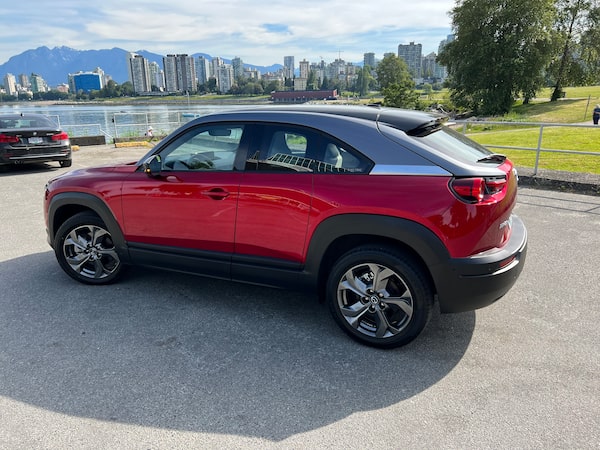
2022 Hyundai Ioniq 5 with a claimed range of 488 kilometres.Jason Tchir/The Globe and Mail
I’m ready to get an electric vehicle. Everyone I know says to get as much range as possible, but I don’t think there are cars in my budget ($40,000 or less) that will get me more than 300 or 400 kilometres. I was thinking of [buying] a used EV with less 200 kilometres of range. I drive to Ottawa to see family once or twice a year, but I feel like I can handle charging a couple of times on the trip [from Toronto]. I live in a condo, but I have a 120-volt outlet near my parking stall. I’ll figure out the details, but what’s the minimum amount of range most people need? – Carolyn, Toronto
When it comes to electric vehicles, range isn’t free. There are a few exceptions, but, generally, the more you spend, the more range you’ll get.
Right now, most EVs range between 300 and 500 kilometres – with a few pricey outliers promising more than 700 kilometres.
But while one survey showed most Canadians want at least 599 kilometres, how much range you actually need depends on how far you typically drive, where you’ll be charging – and how much range you can afford, experts say.
“[People who say they need 599 kilometres] are people who don’t understand EVs and they’re used to having a big gas tank. But there are plenty of city drivers who don’t need to pay the extra money,” said Cara Clairman, chief executive officer of Plug’n Drive, a pro-electric vehicle not-for-profit. “There are people who just commute 20 kilometres a day, so it doesn’t make sense for them to have a 600-kilometre battery pack. But if you use your car regularly for road trips, that’s a whole different scenario.”
To figure out the range you’ll need, Clairman suggests keeping track of exactly how far you drive.
“A lot of people think they drive more than they do because they’re sitting in traffic for an hour,” Clairman said. “My first EV was a Leaf with 130 kilometres of range and it even worked for trips. Once in a while, it wasn’t enough [range] and I would rent a car. Now I’m driving more, so I got a [Chevrolet] Bolt.”
Estimates vary, but the average Canadian drives about 40 kilometres a day, Clairman said. When BMW first considered bringing an EV to Canada, it said its research showed the average Canadian drives 45 kilometres a day.

2022 Mazda MX-30 with a claimed range of 160 kilometres.The Globe and Mail
No extra charge?
But even if you’re not driving long distances on an average day, if you’re considering an EV with low range – say, less than 200 kilometres – it’s wise to keep in mind those occasional higher mileage days, too.
Personally, I was reminded of that this month when I test drove a 2022 Hyundai Ioniq 5 (with a claimed range of 488 kilometres) one week and a 2022 Mazda MX-30 (claimed range of 160) the week after that.
With the extended range Ioniq 5, I didn’t worry about range all week, despite a hiking trip from Vancouver to Squamish, B.C., that took me about 70 kilometres each way. I even drove it in Sport mode, which uses more power at the expense of range, and blasted the air conditioning, which also eats range, to keep my dog cool in the back. I got back with more than 300 kilometres to spare. (But you pay for that peace of mind. The well-equipped Ioniq tester I drove was priced at $62,824, though there is also a 354-kilometre-range version starting at $47,550.)
On that same Squamish route in the Mazda ($49,950 as tested) a week later, I felt pressure to keep track of every kilometre driven. Even though I drove at exactly the speed limit with the windows down and regenerative braking set to maximum – all to maximize range – I got back with just 30 kilometres to spare and the low-battery warning on the display.
It was more than enough to get home, but if I’d decided to go 15 kilometres farther to hike at another spot, I wouldn’t have made it back without charging.
That kind of range is fine for daily driving – but it’s not ideal for spontaneous outings.
Sure, I could have stopped at a charger, but I know the limited range would keep me from longer trips unless they were absolutely necessary.
Because I was charging at a 120-volt outlet in my condo parking stall, I’d have needed to charge for 16 hours to get to full range if I wanted to make a similar trip again. It’s all manageable, but it’s not convenient – especially considering that many fast chargers around Vancouver are usually busy.
I often visit family in Kelowna, B.C., and Alberta, so for me, the sweet spot for range is somewhere between 350 and 400 kilometres.
One place to compare EV ranges is Natural Resources Canada’s website, which lists several vehicles with less than 300 kilometres of range, including the 2022 Tesla Inc. Model 3 Standard Range (146 kilometres; this model can only be ordered directly from the Tesla store), the 2022 Mazda MX-30 (160), the 2022 Mini Cooper SE (183) and the base 2022 Nissan Leaf (240).
But out of 81 models listed for 2022, 75 have more than 300 kilometres of range.
Your actual range will vary, depending on how you drive, the temperature outside and the steepness of the roads.
Have a driving question? Send it to globedrive@globeandmail.com and put ‘Driving Concerns’ in your subject line. Emails without the correct subject line may not be answered. Canada’s a big place, so let us know where you are so we can find the answer for your city and province.
 Jason Tchir
Jason Tchir